When you Google something, you may see an ad at the top of the search results. Like this:
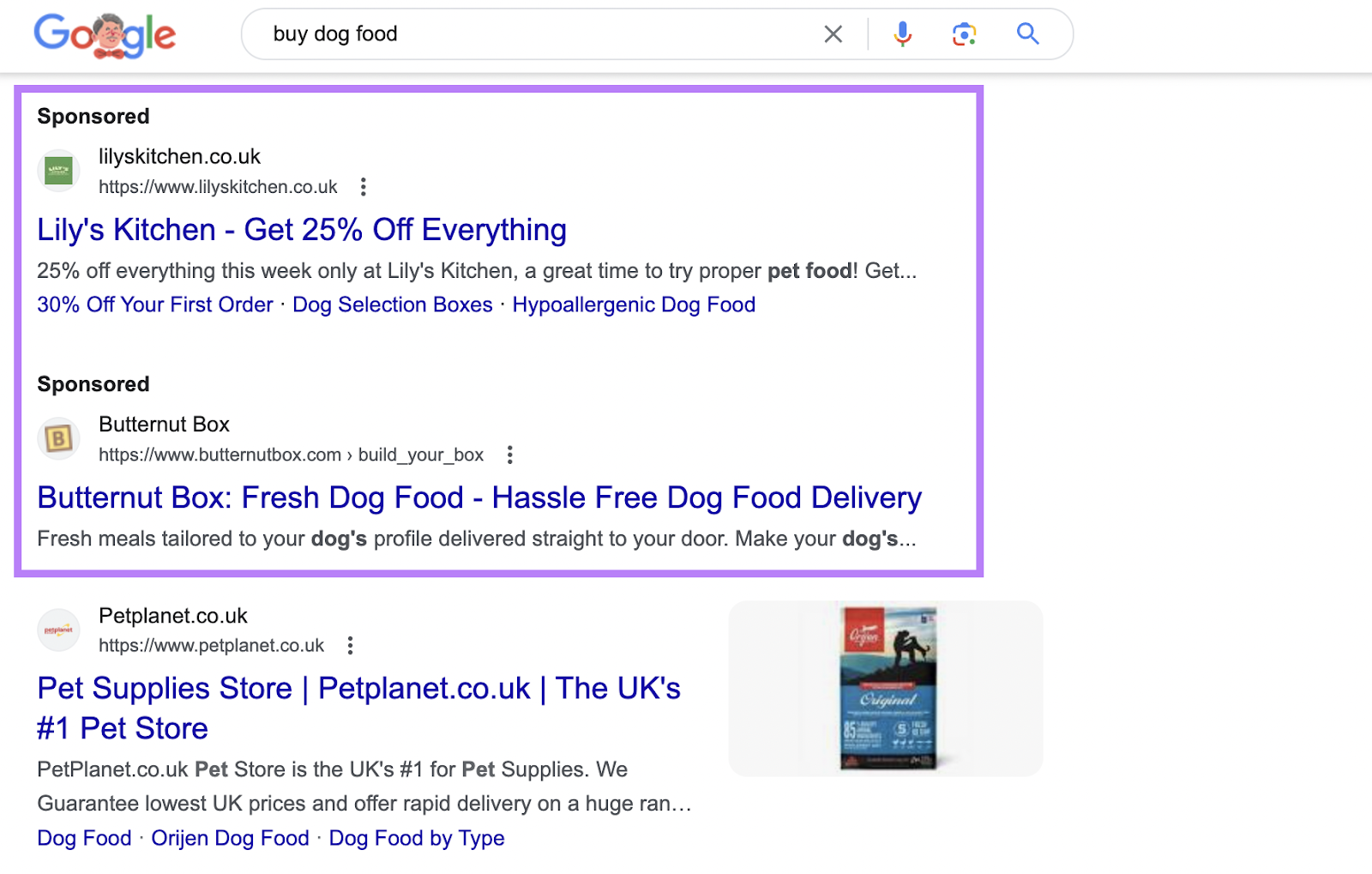
That’s a Google ad.
But that’s only one type of Google advertising, appearing in just one place.
In this article, we’ll talk about different types of Google ads, how they work, and how you can launch your own campaign.
Let’s start with the Google Ads basics.
What Is Google Ads?
Google Ads (previously known as Google AdWords) is an online advertising platform that lets you advertise your products or services across Google’s online properties. Such as its search engine, partner websites, and YouTube.
Here’s what the Google Ads overview dashboard looks like:
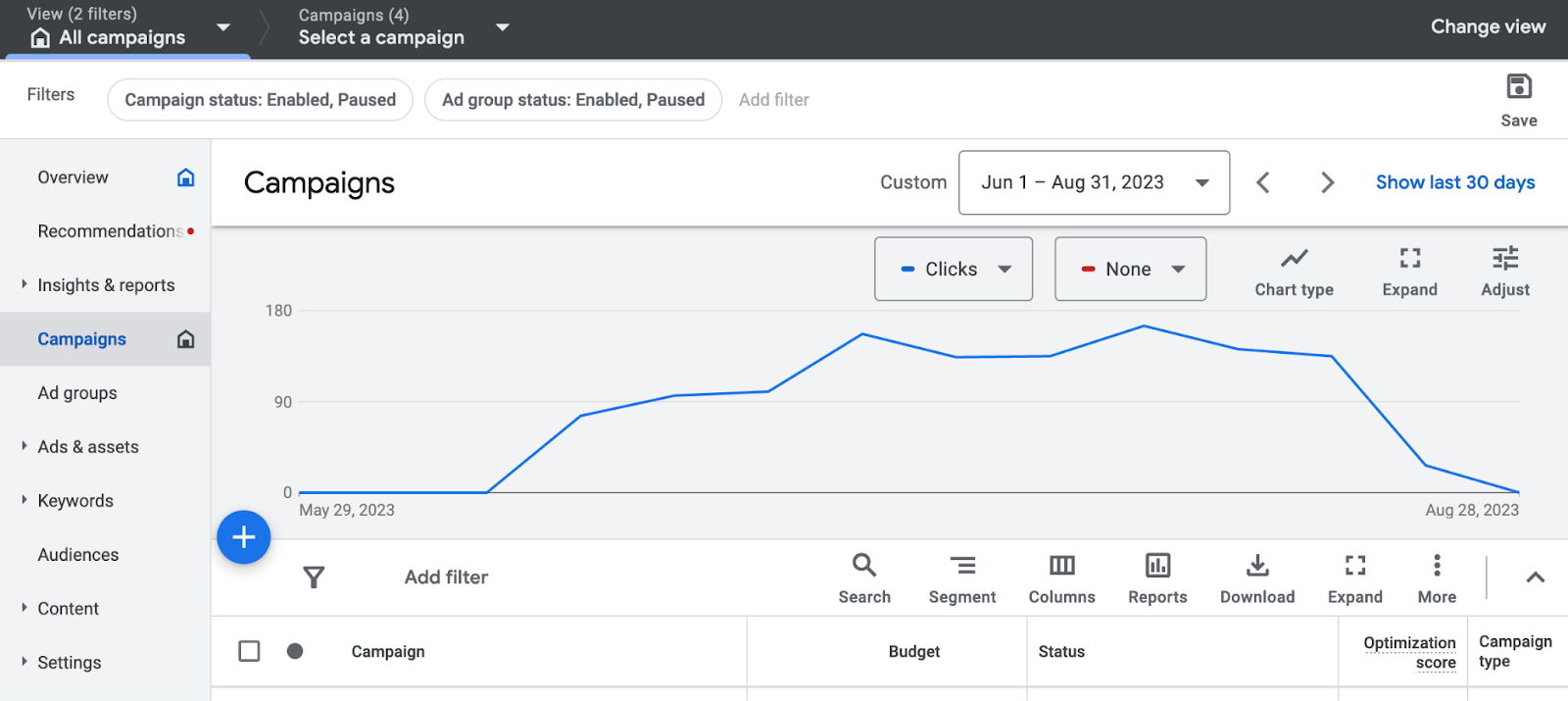
Note: When we say “Google Ads,” we’re referring to the advertising platform. When we say “Google ads,” we’re talking about the actual advertisements on Google properties.
You pay a fee for your ads to appear on Google. A process called “bidding” determines the cost.
Think of bidding as an auction where a business decides the maximum amount it’s willing to pay for someone to click on its ads.
But why pay when there are free listings on Google?
These free listings are called organic results. They appear based on their relevance to users’ search queries. And Google uses hundreds of factors to rank them organically.
This is entirely different from how Google decides which ads to display. (We’ll discuss this in the How Does Google Ads Work section below.)
Why Use Google Ads?
The benefits of Google Ads include:
1. Immediate Visibility
Google Ads ensures that your advertisement gets seen promptly.
Ads are displayed prominently based on factors like your bid amount and ad quality.
This ensures that, if you have a new product launch or a special promotion, it gets the attention it deserves right away. Without a long waiting period.
2. Flexibility
Google Ads provides a range of ad formats to suit different business needs.
Whether you prefer to use text, images, or videos, there’s an ad format that will help you convey your message effectively.
3. Precise Targeting
Google Ads offers precise targeting options. You can focus your ads on a particular audience by choosing specific age groups, interests, or geographic areas.
Here’s how it looks to target your audience by interest:
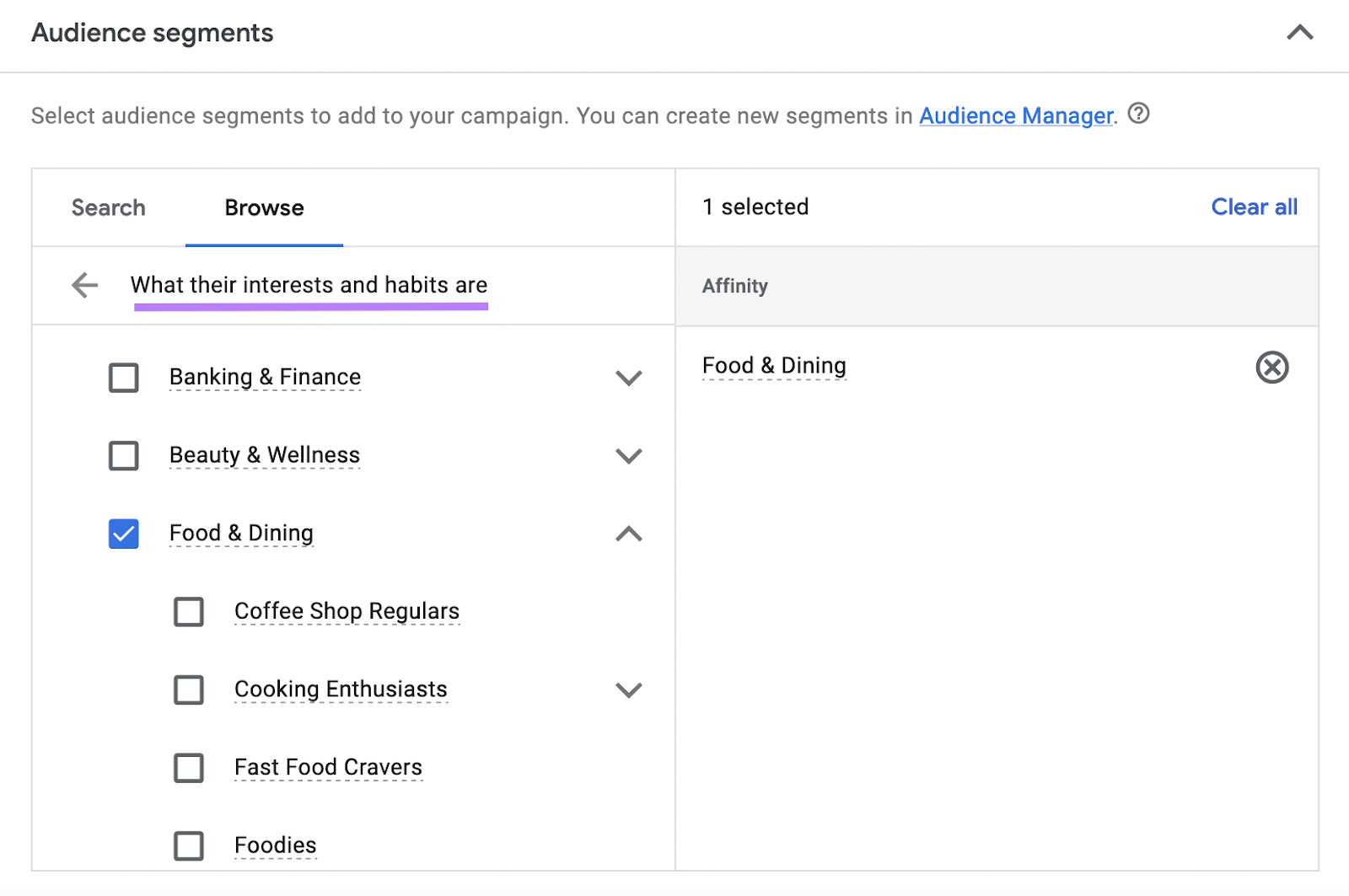
For example, a local restaurant can specifically target ads to people interested in “Food & Dining.”
Google determines the interest based on users’ search history, the websites they visit, and the apps they use. This ensures the restaurant reaches an audience looking for culinary offerings.
4. Remarketing
Google Ads allows you to re-engage users who have previously visited your website but didn’t complete a desired action. Like making a purchase or signing up for a newsletter.
It displays your ads on other sites they visit, keeping your brand in their mind.
Retargeting increases the chances of these potential customers returning to your site and converting.
5. Cost-Effective
The primary pricing model of Google Ads is pay-per-click (PPC), where you’re charged when someone clicks on your ad. The platform also offers other pricing options like cost per thousand impressions (CPM) and cost per action (CPA).
These flexible options allow you to choose the most cost-effective model for your specific campaign goals, optimizing your spending for better results.
6. Measurable Results
Google Ads comes with comprehensive performance reports.
You can track various metrics, from the number of views and clicks your ad receives to the conversions it drives.
You can then use this data to identify which ads perform best, allocate the budget more efficiently, and refine your targeting to improve your campaign’s effectiveness.
With Google Ads, you can achieve various advertising goals. Like increasing website traffic, capturing leads, and driving sales.
However, the success of your ads depends on several factors. Including the type of Google paid ads you choose.
Types of Google Ads
Here are five types of Google ads:
1. Google Search Ads
Google search ads appear on Google’s search engine results pages (SERPs) when users search for specific keywords.
Here’s one of the Google search ads examples for the query “buy firm mattress online”:
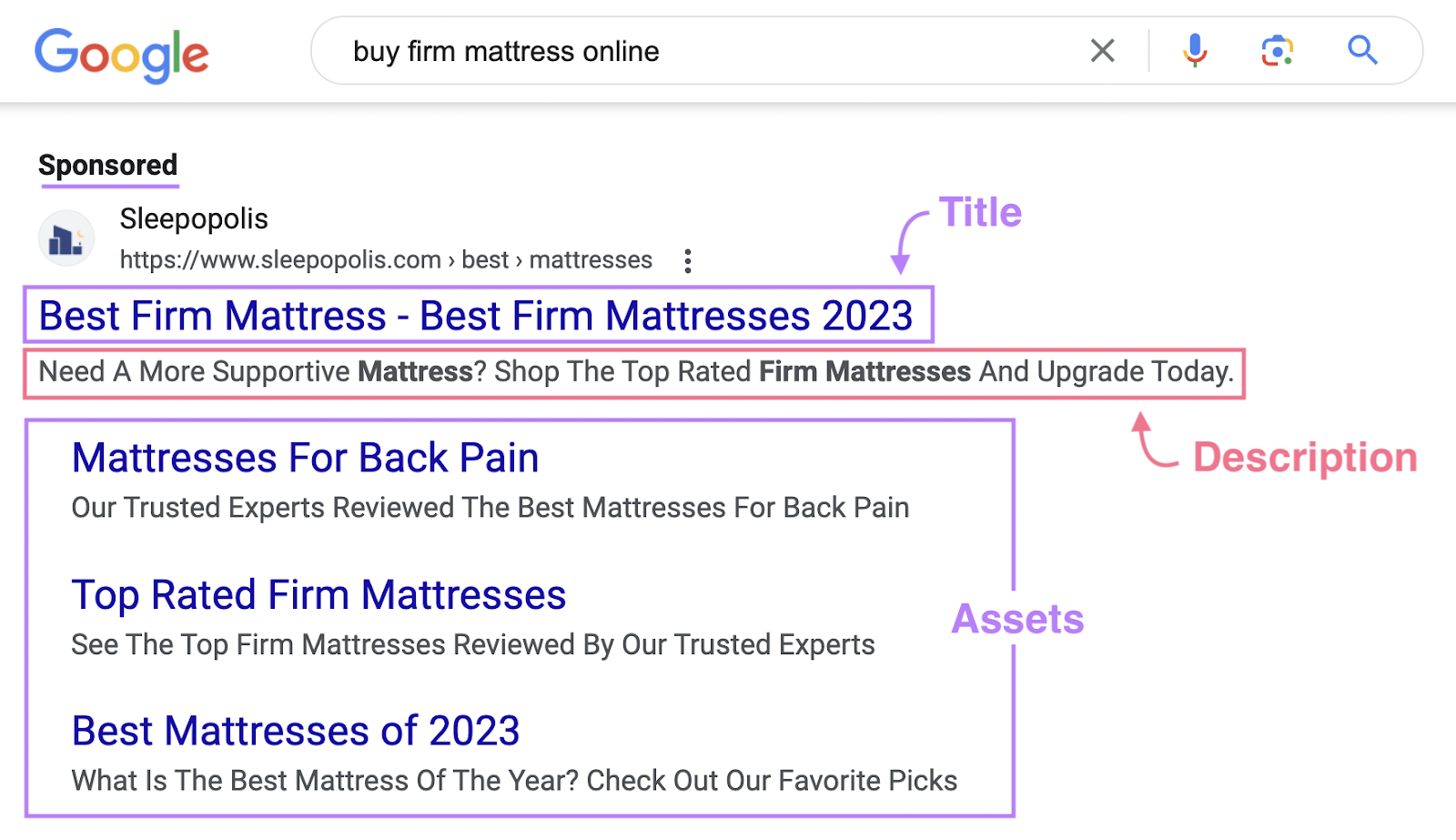
This ad includes three key elements:
- Title & description: The headline and additional text offer a quick overview of the product or service
- Ad Assets: Previously known as extensions, these are additional details like specific page links, which you can select during ad setup
The positioning of these ads is typically at the top or bottom of Google’s SERP. And the number of ads displayed on the page can vary based on factors like the search query’s popularity.
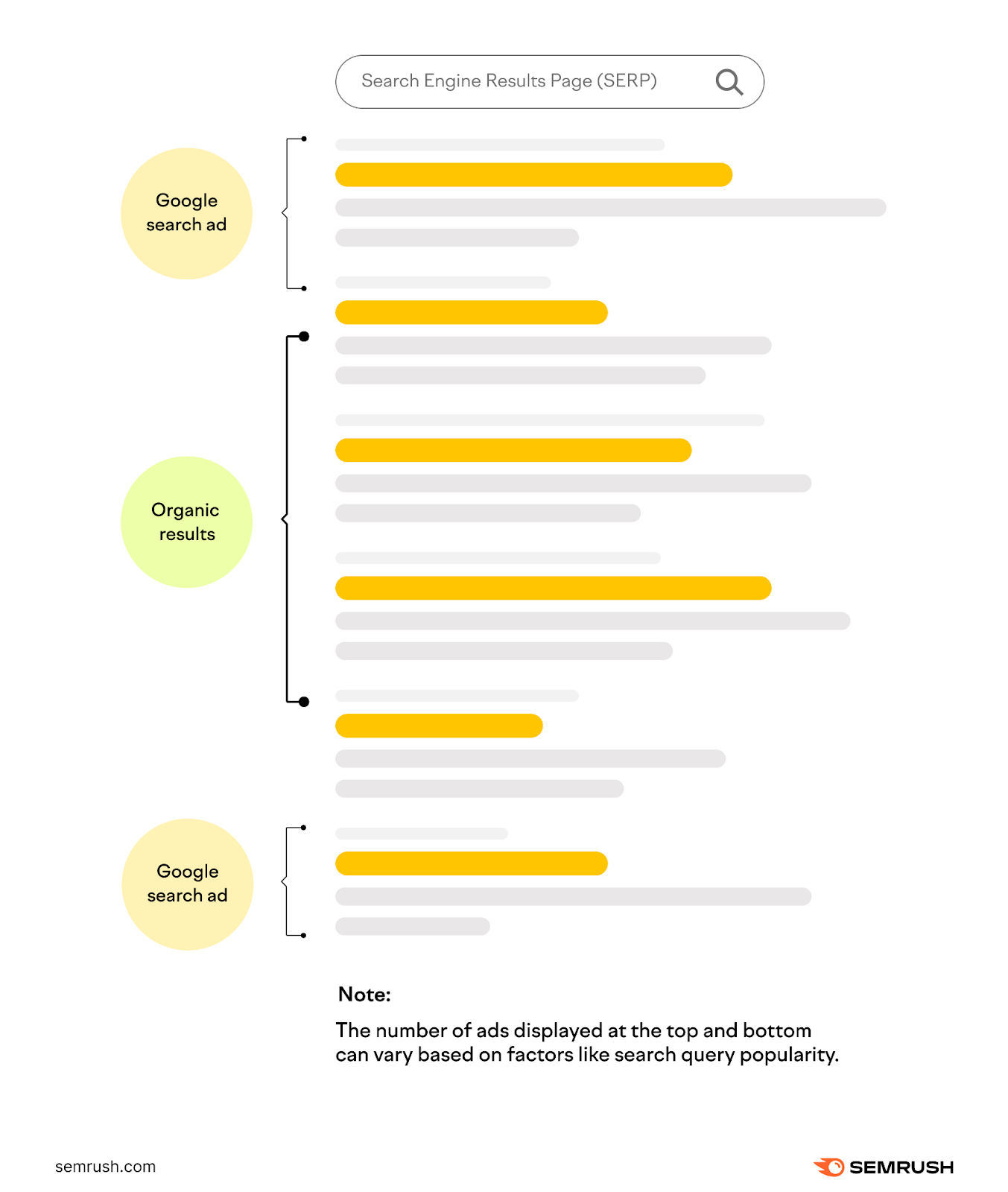
Ads on Google match the intent of the user’s search query.
They help you connect with potential customers at the exact moment they’re actively searching for related products or services.
For instance, if someone searches for “best running shoes,” a shoe store can display its ad at the top of the search results, ensuring high visibility.
For easy setup of Search campaigns, you can use the Ads Launch Assistant app. The app lets you manage Google Ads campaigns from start to finish with AI and Semrush data.
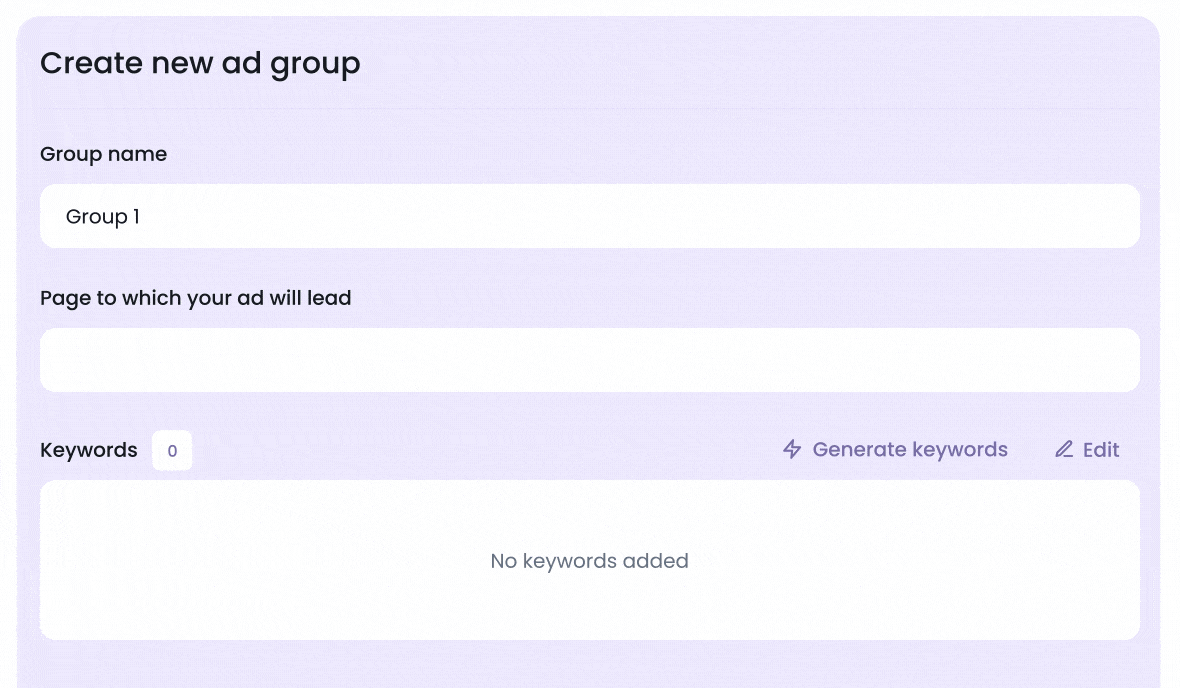
Just insert your URL, language, and location to get keyword suggestions and AI-generated ad copy. Confirm your campaign, select your budget, and start your Google Ads campaign.
2. Google Display Ads
Google Display Network (GDN) ads are visual ads that appear on websites, apps, and other digital platforms that have partnered with Google to host ads.
These platforms team up with Google through a program called AdSense. It allows them to showcase relevant ads served by Google to their visitors.
Here’s an example of a Google display ad on the Washington Post website:
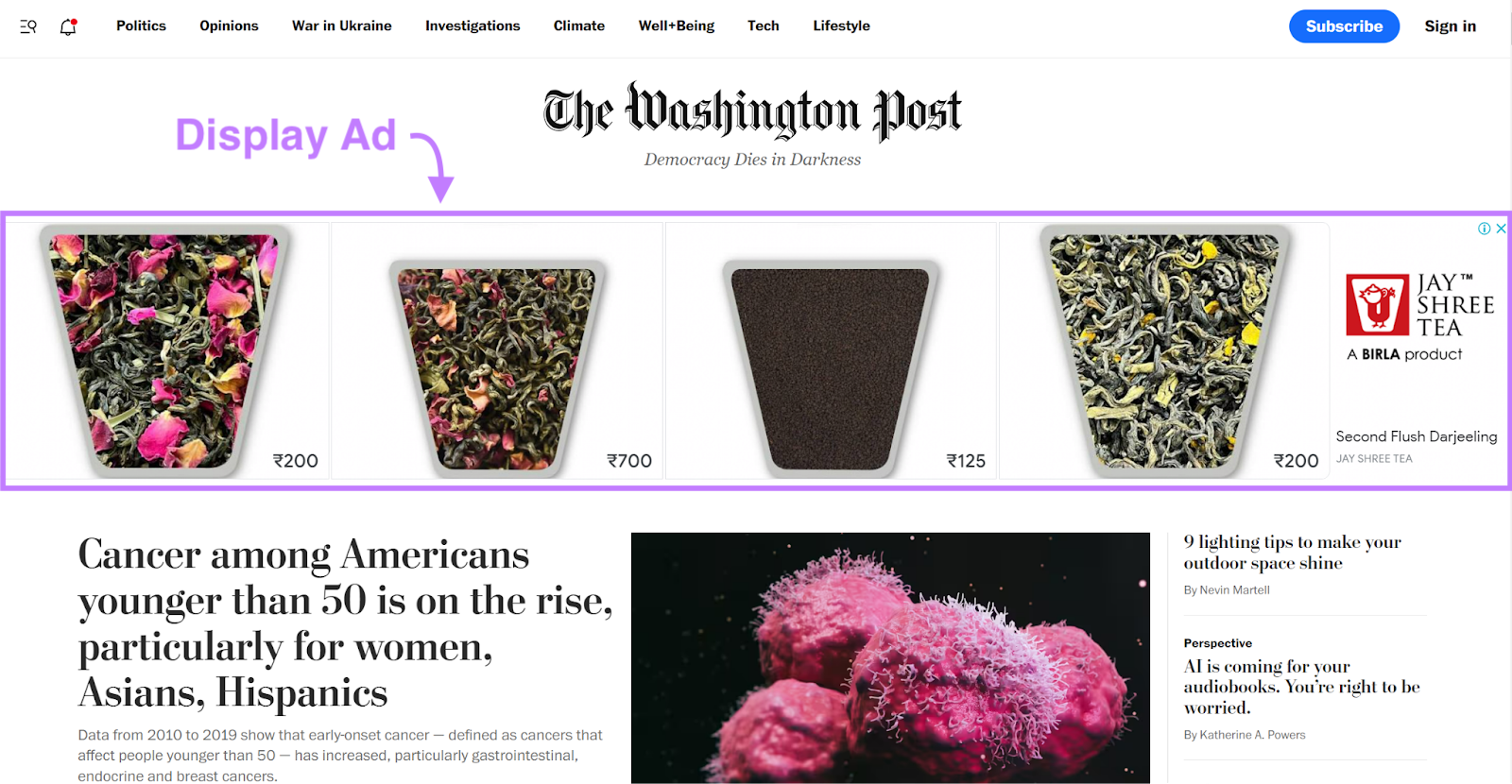
Website owners can choose to show these ads in various places on a webpage. Some standard placements include the top of the website (banner), sidebar, and footer.
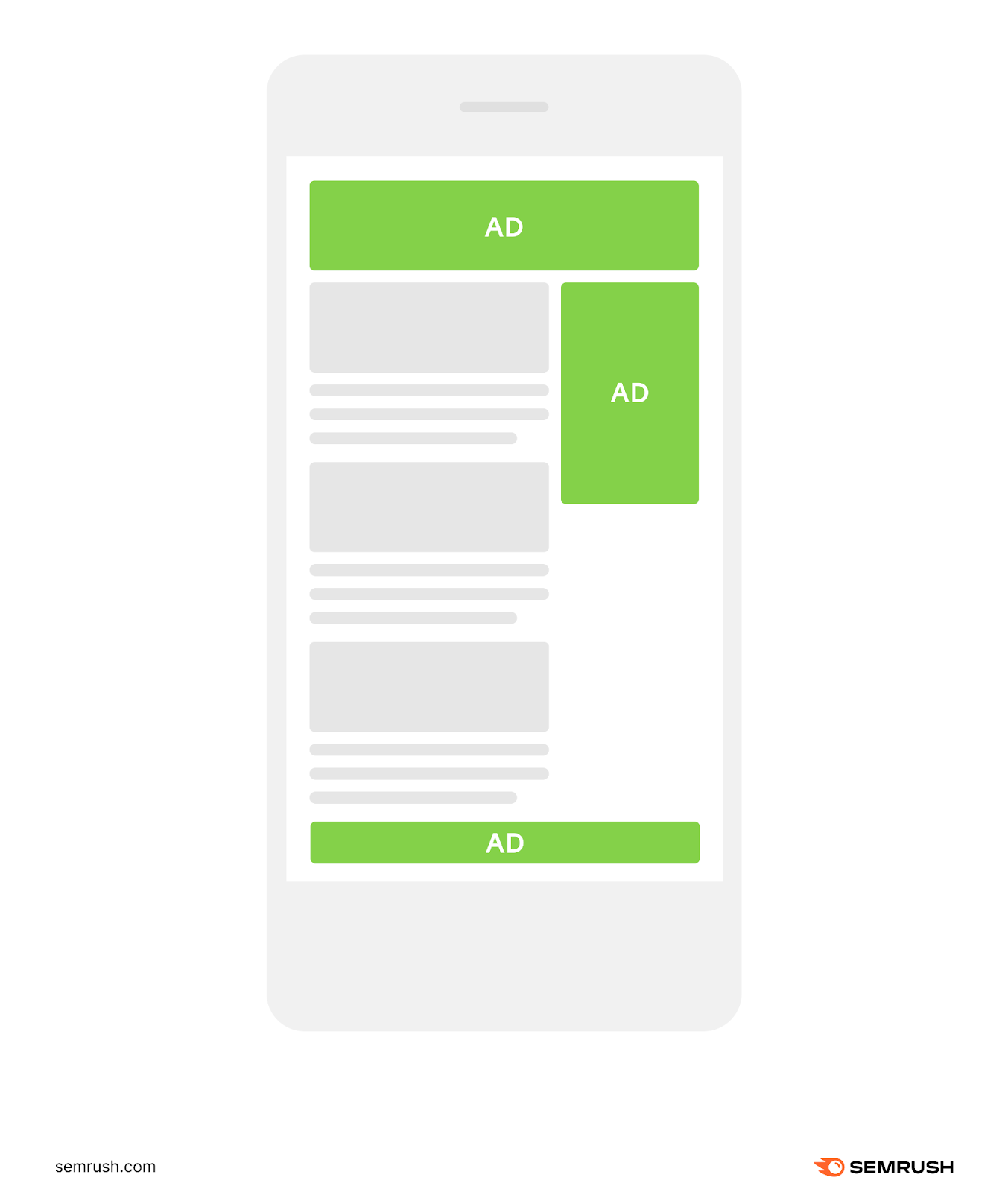
Google display ads help you reach people not based on what they’re searching for but based on who they are and what they’re interested in.
So, instead of showing up when someone searches for a specific term, these ads appear based on a person’s interests or the kind of content they’re viewing.
For instance, if you often read articles about fitness, you might see an ad for running shoes when you’re on a news website.
In this case, the Google Display Network recognizes your interest in fitness and shows you relevant ads. Even if you’re not actively searching for running shoes.
3. Google Shopping Ads
Google Shopping Ads showcase products directly in the search results with an image, price, and store name. They appear when users search for specific products on Google.
Here’s an example:
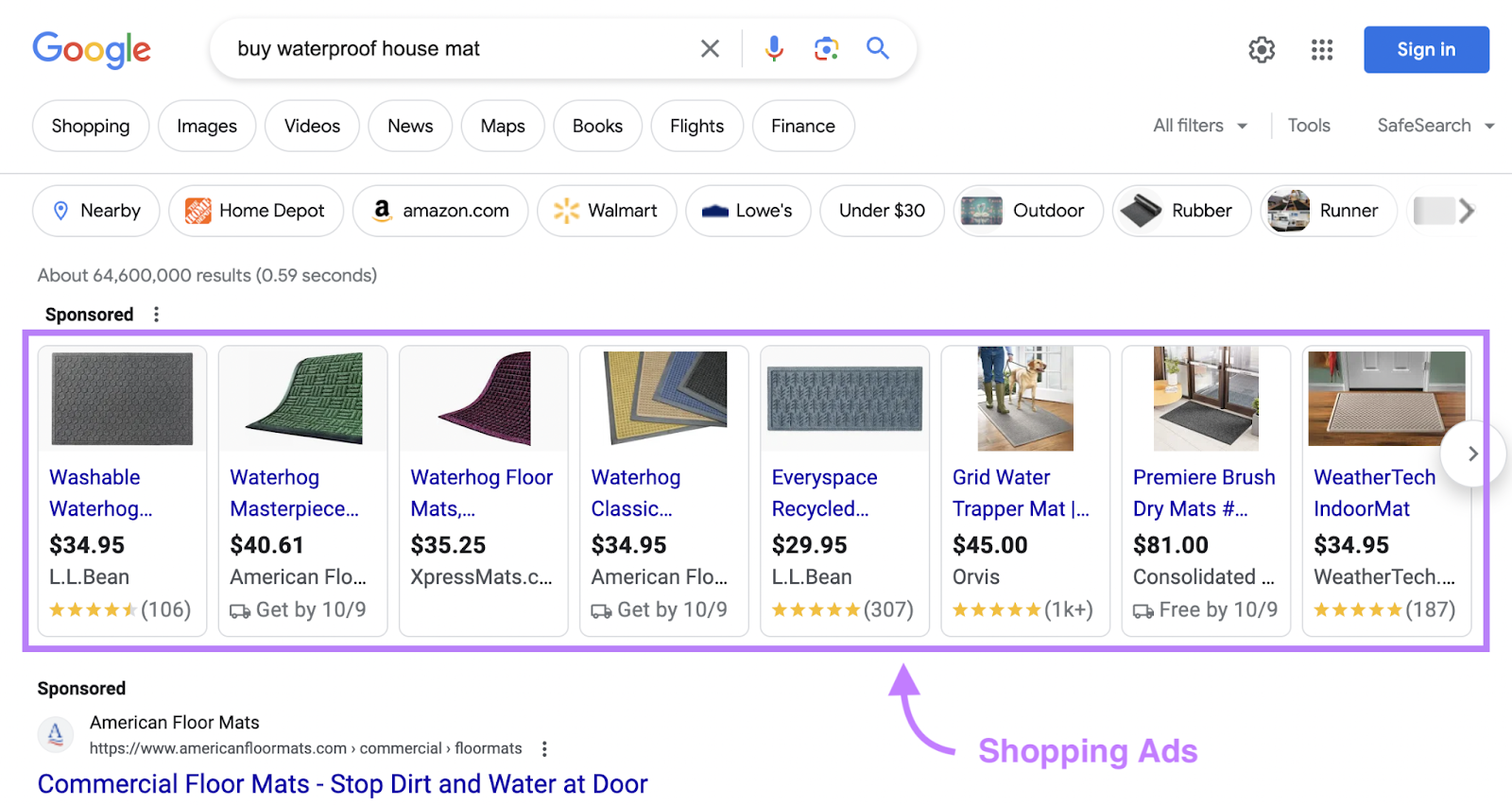
The main benefit of Google Shopping Ads is the visual and detailed product presentation. It’s like having a digital storefront on Google.
If users type in “wireless headphones,” they’ll see a range of products with images and prices. Allowing them to compare and choose directly from the search results.
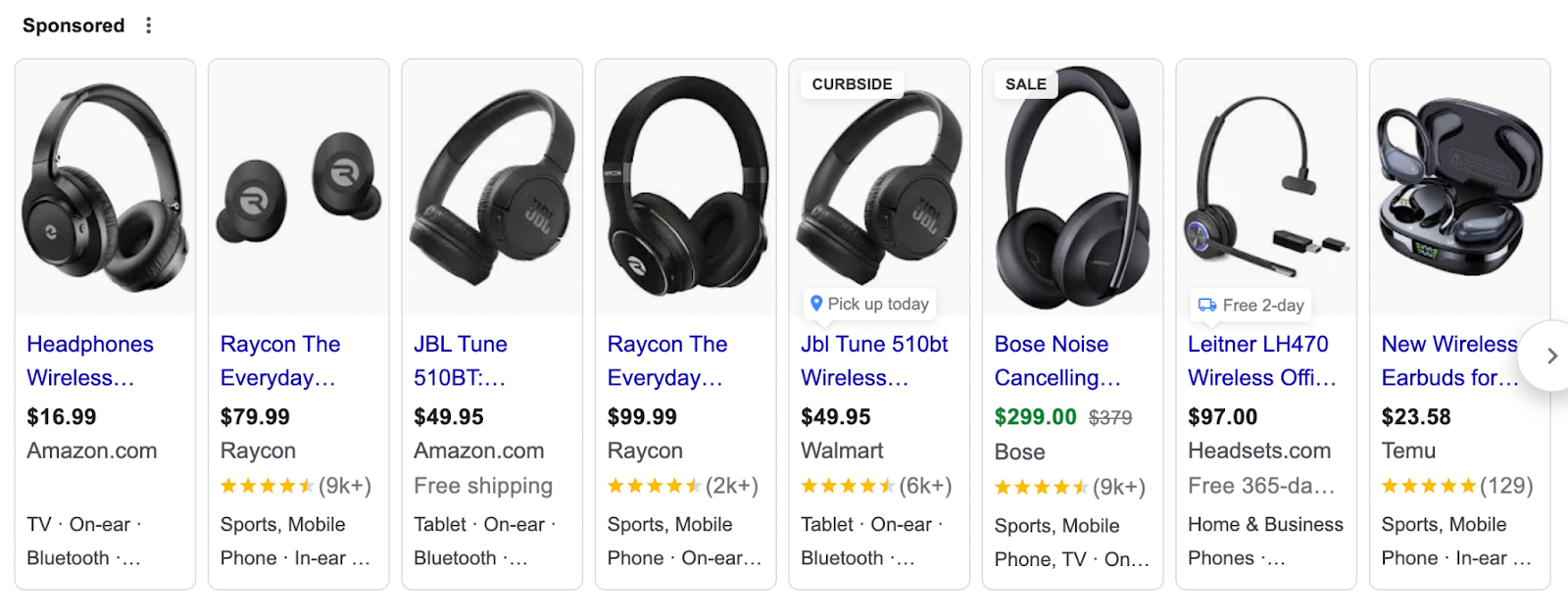
4. Google Video Ads
Google video ads are advertisements that appear on YouTube. These ads can play before a user’s selected video (pre-roll), during longer videos (mid-roll), or after the video has finished (post-roll).
Here’s an example of a video ad playing before the start of a video:
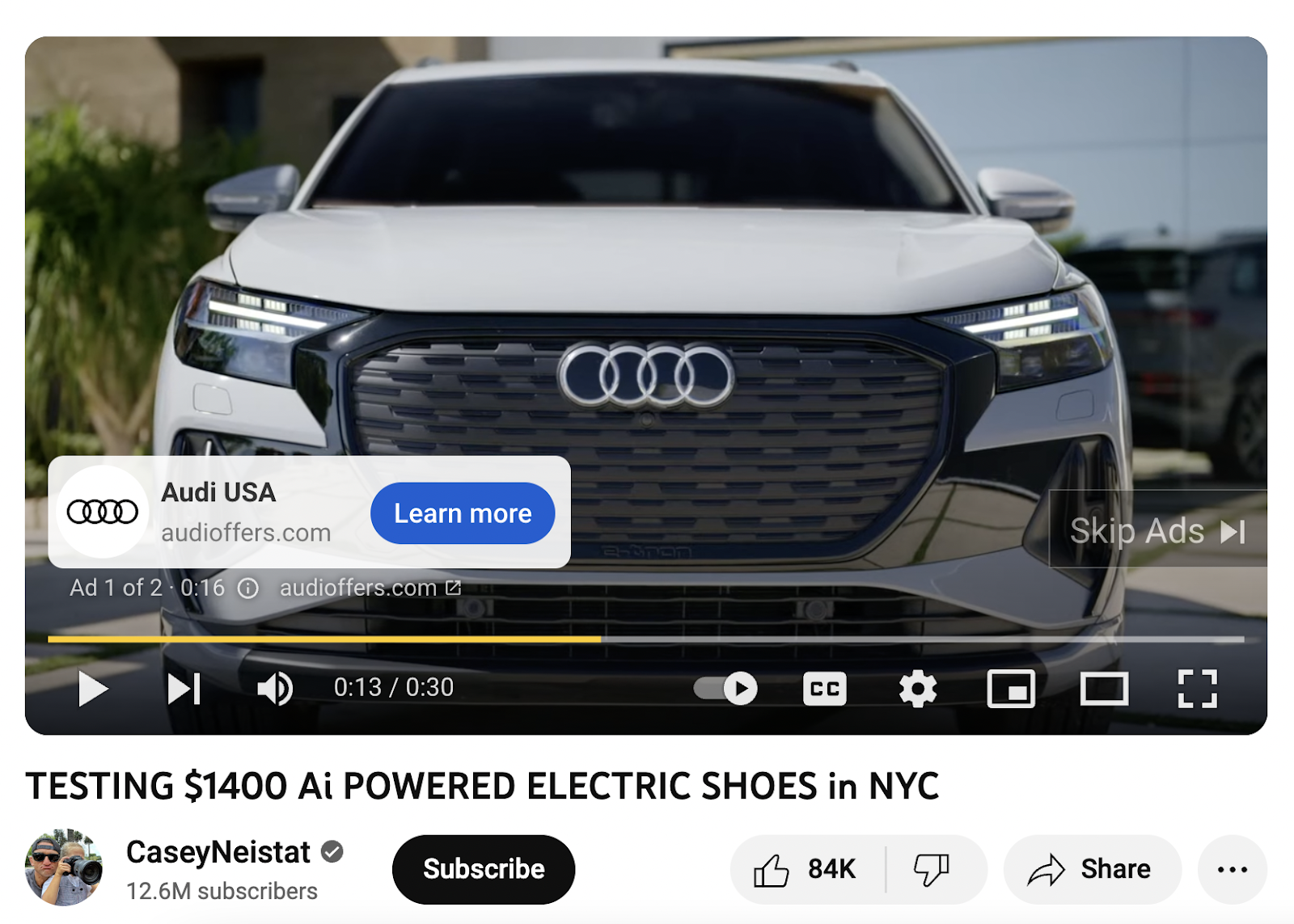
With YouTube being one of the largest search engines in the world, you can use these ads to reach a large number of people.
Google video ads leverage the power of visuals, sound, and storytelling. This multimedia approach can help you evoke emotions, demonstrate your product’s functionality, or simply entertain—making your online advertisement memorable.
You can display your video ads based on specific viewer interests, demographics, or even the type of content they’re watching.
So, a cosmetic brand might target viewers watching beauty tutorials, ensuring its ad is relevant and timely. Or a travel agency might target viewers watching travel vlogs or destination reviews.
5. Google App Ads
Google app ads help you get your mobile application in front of the right audience.
You have to provide essential elements like text and images. And Google takes care of automatically creating various ad formats. Which can appear in multiple locations across Google’s ecosystem, including its search engine, Google Play Store, YouTube, and the Google Display Network.
Here’s an example of a Google app ad on YouTube, prompting users to download the app:
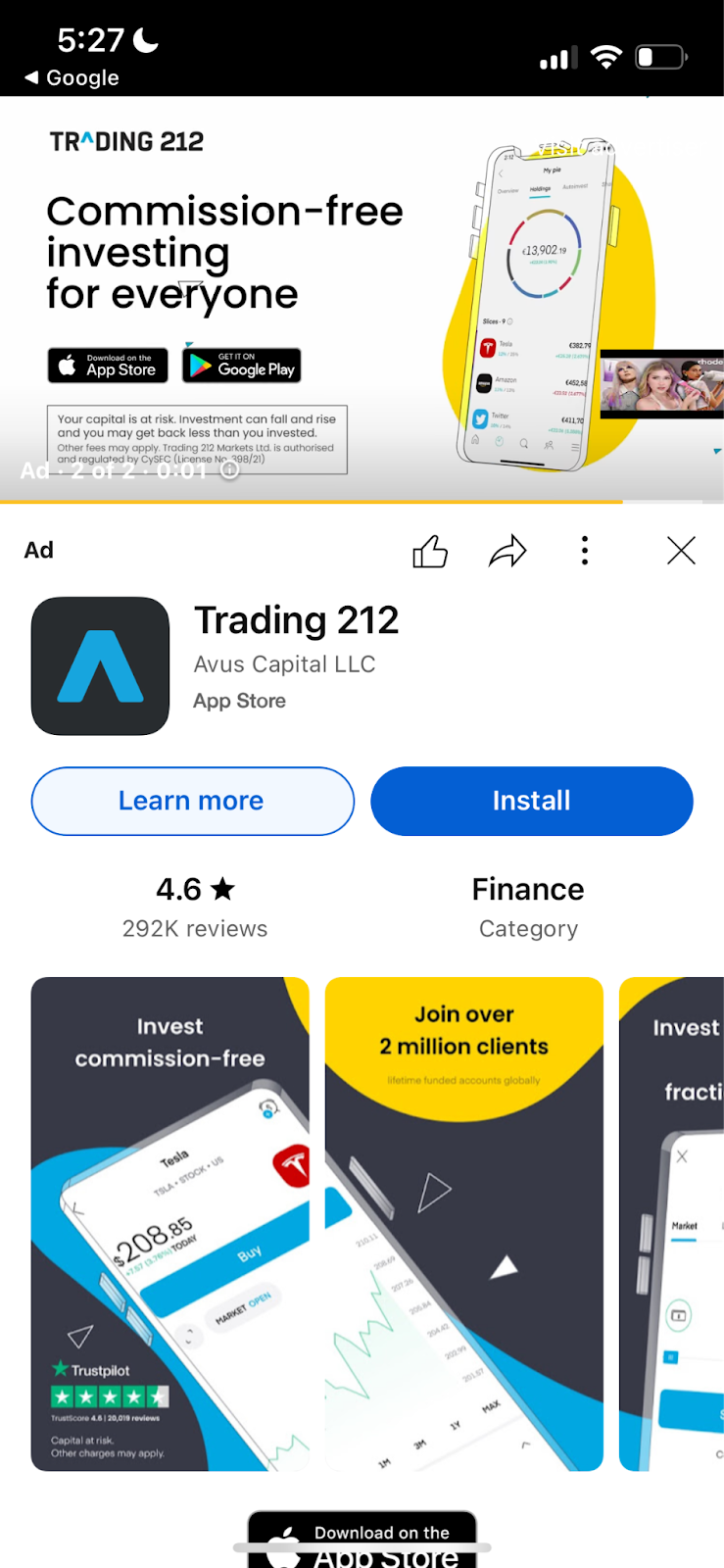
There are three subtypes of app campaigns based on goals:
- App installs: Aimed at getting more people to download your app
- App engagement: Focuses on encouraging current users to interact with your app
- App pre-registration: Allows Android users to sign up to get notification when a new app becomes available
How Does Google Ads Work?
Google Ads shows advertisements based on your bid, the ad’s relevance to users, and its quality.
It ensures that users see ads that align with their interests and needs. And advertisers reach audiences that are more likely to convert.
So, let’s first understand the key concepts in Google Ads:
Google Ads Auction
Whenever anyone searches on Google or visits a site that’s part of the Google Display Network, an automatic auction occurs in the background based on your preset settings.
In this automated auction, you and other advertisers bid to have your ads displayed.
On your Google Ads account, you need to set the maximum amount you’re willing to pay for a click or impression (pictured below). This is your bid.
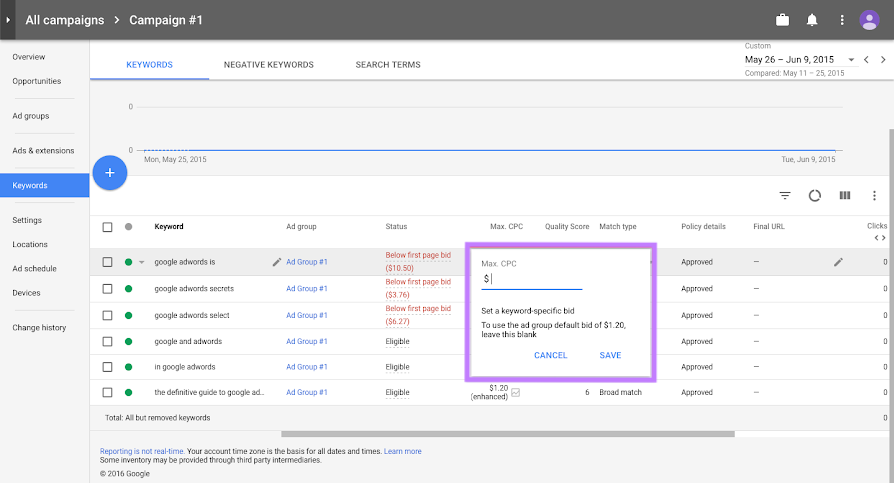
The auction determines which ads get displayed—and where.
However, earning a prominent position (like the first few listings on a search results page) isn’t just about bidding the most money. Google also assesses the ad’s relevance and quality.
Relevance and Quality
“Relevance” means how closely your ad matches a user’s search intent or the content they’re viewing.
For example, if someone searches for “running shoes,” an ad for sports sneakers would be more relevant than one for high heels.
Google also evaluates the “quality” of users’ experience when they click on your ad.
This is referred to as “Quality Score.” It's a metric that evaluates your ad’s overall quality and relevance.
Scored out of 10, the Quality Score combines the performance of three components:
- Expected click-through rate (CTR)
- Ad relevance
- Landing page experience
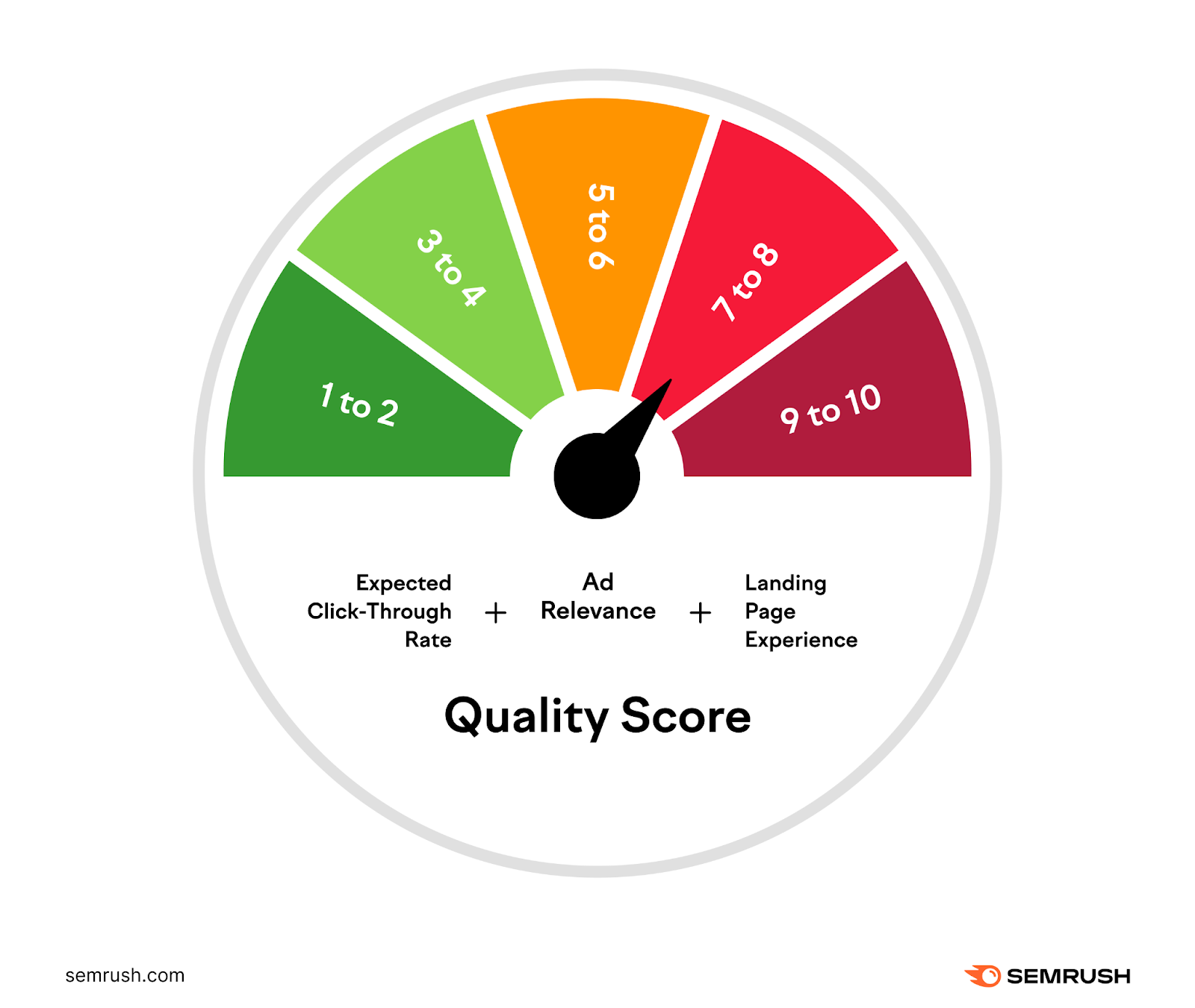
Ad Rank
Ad Rank is a value that influences where your ad appears on Google’s SERP or within the GDN.
Various factors inform your Ad Rank. Including your bid amount, your Quality Score, the competitiveness of the auction, and the user’s location.
It’s like a ranking system for ads. The higher your Ad Rank is, the more prominently your ad will be placed.
So even if you bid less than other advertisers, you could still win a better position if your ad is higher quality and more relevant.
These key concepts collectively decide which Google Ads appear and where.
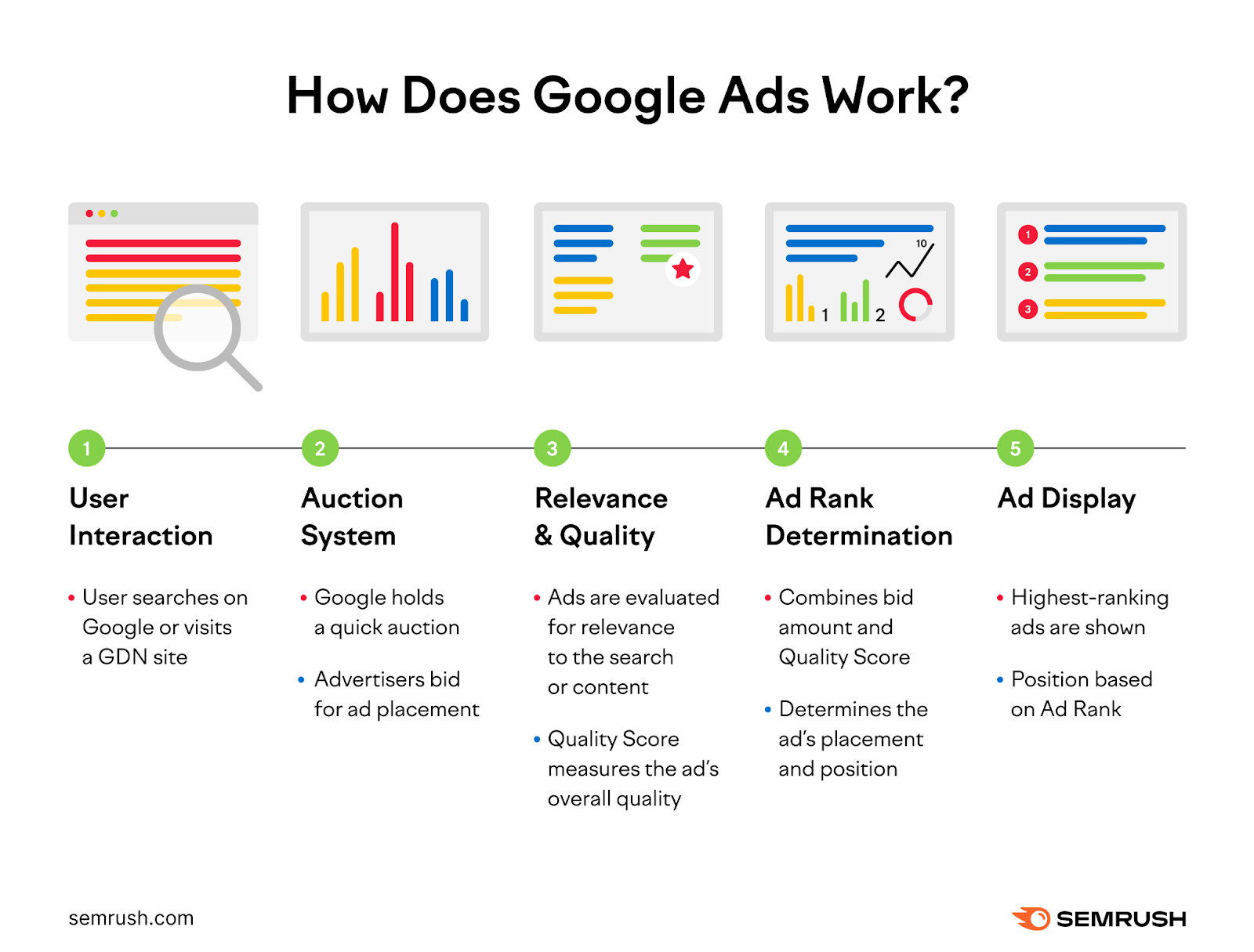
However, the way each type of Google ad operates can vary. Let’s look at how different Google ad types function:
How Do Different Types of Google Ads Work?
Google Search Ads
When a user enters a query, Google’s algorithm evaluates all ads set to target that keyword.
These keywords are the specific terms you’ve chosen to target in your campaign. You can set a “match type” for each keyword, which controls how closely the user’s query needs to align with your keyword for your ad to appear.
Match types can be:
- Exact: Exact keyword match required
- Phrase: Exact phrase with additional words allowed
- Broad: Any word in the keyword phrase, in any order
Once the algorithm identifies ads with relevant keywords and appropriate match types, it ranks these ads.
The ranking is based on a combination of factors such as bid amounts, the ad’s relevance to the search query, and the ad’s Quality Score.
Only the highest-ranking ads are displayed. And their position is determined by Ad Rank.
To ensure your ads rank well, keyword research is crucial. It will help you target the relevant search queries and create quality ads that match users’ search intent.
You can use Semrush’s PPC Keyword Tool to create, manage, and optimize your keyword lists for your ad campaigns.
Go to the tool and enter your domain. Then, click “Set up.”
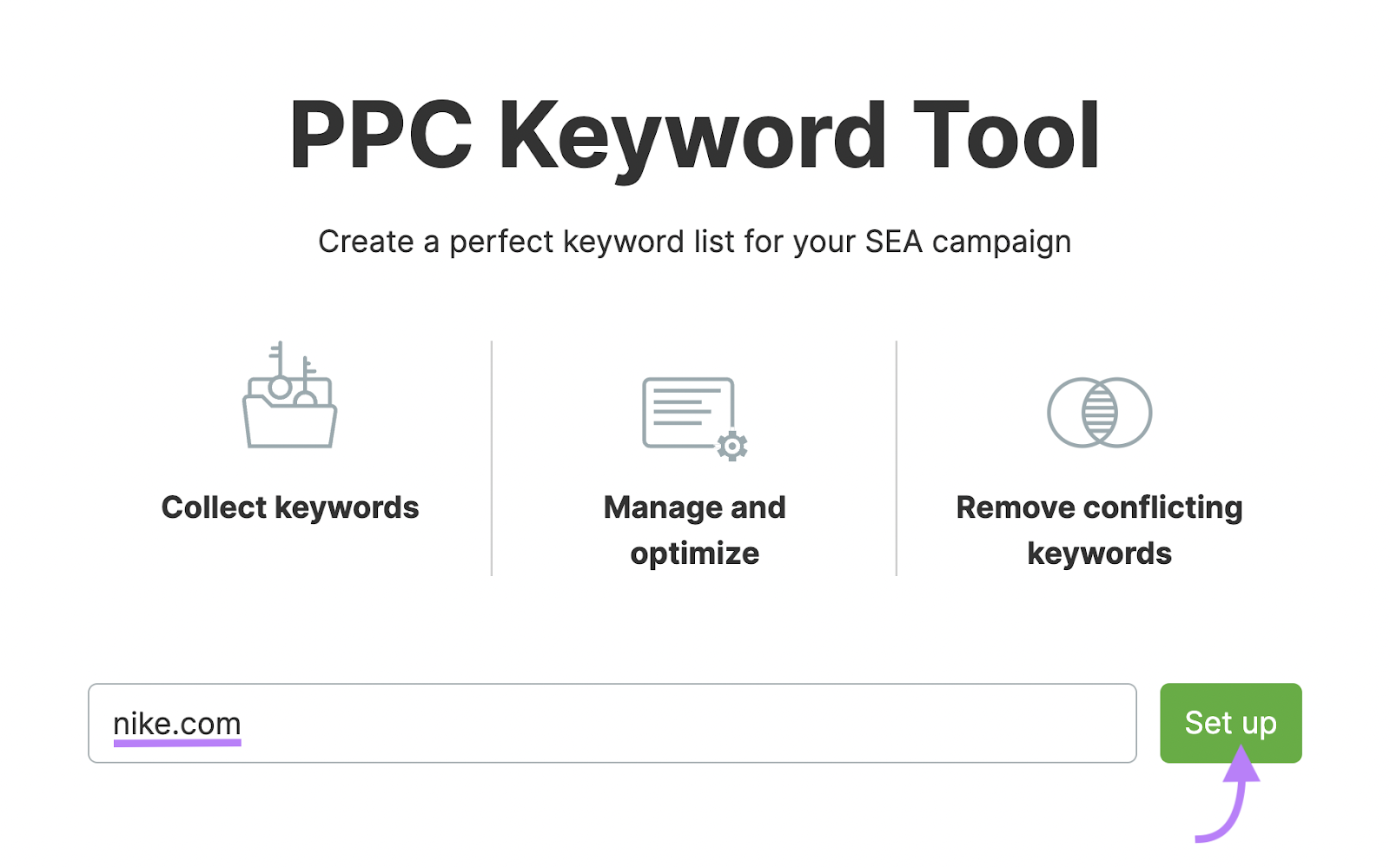
Select “Manually.” It’s the simplest way to add keywords.
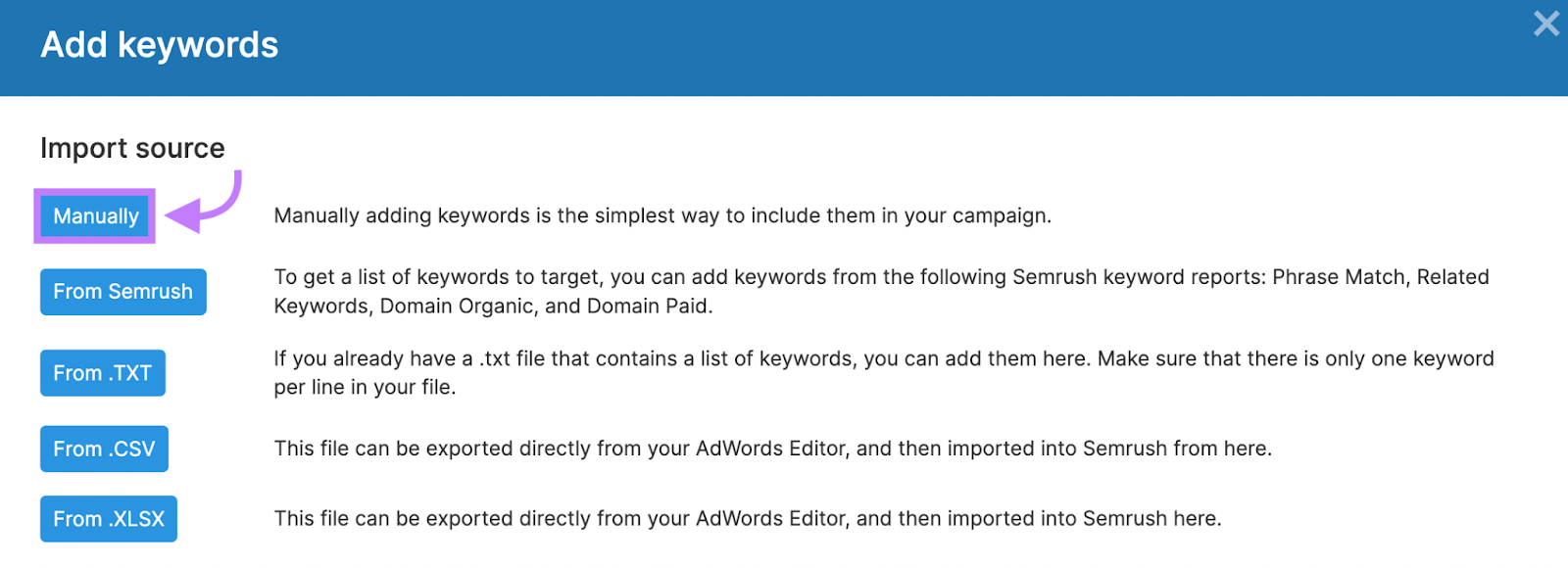
Next, enter your keywords and add your target location. Then, click “Start PPC Keyword Tool.”
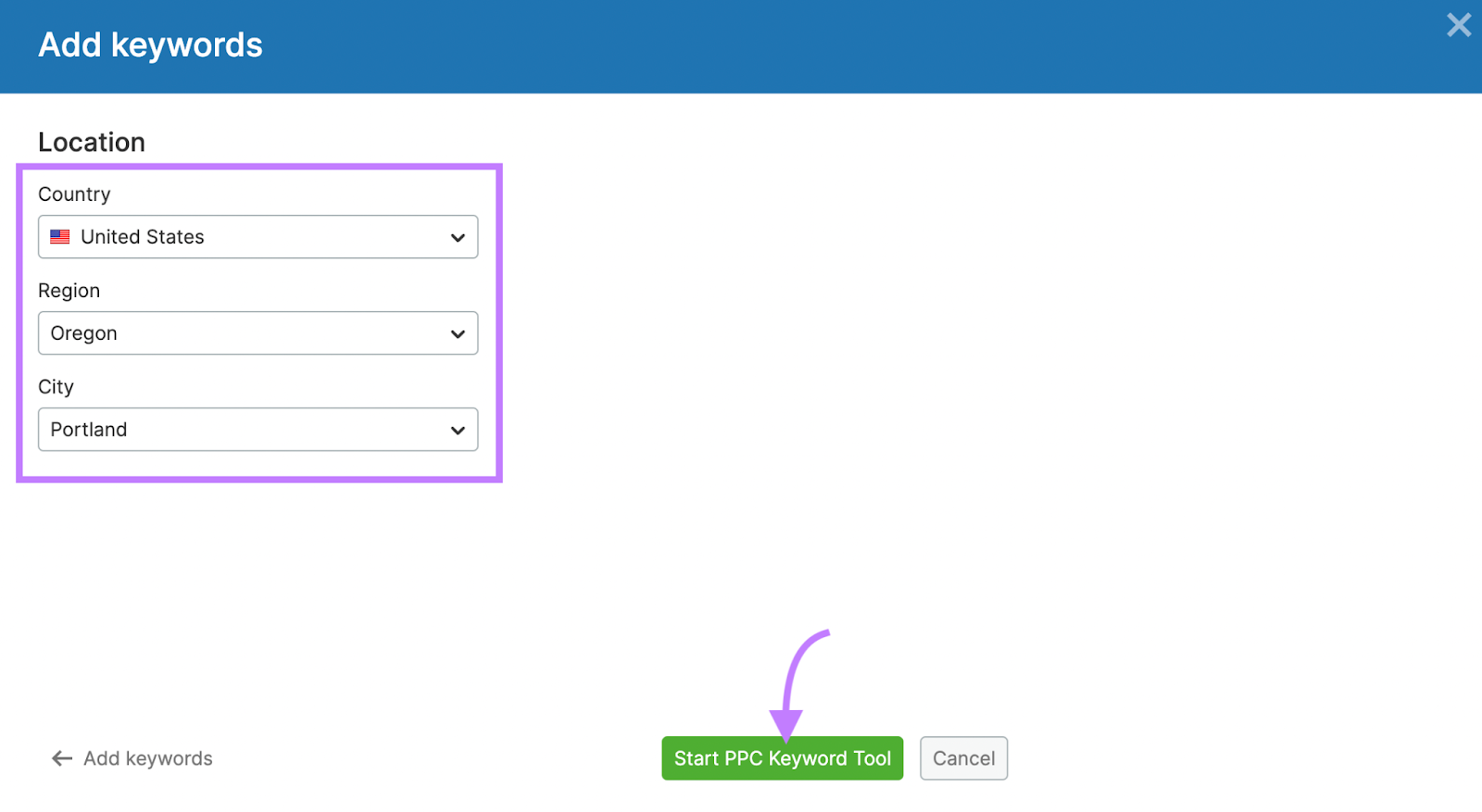
From the main dashboard, you can clean and organize your keywords for your Google paid search ad campaign.
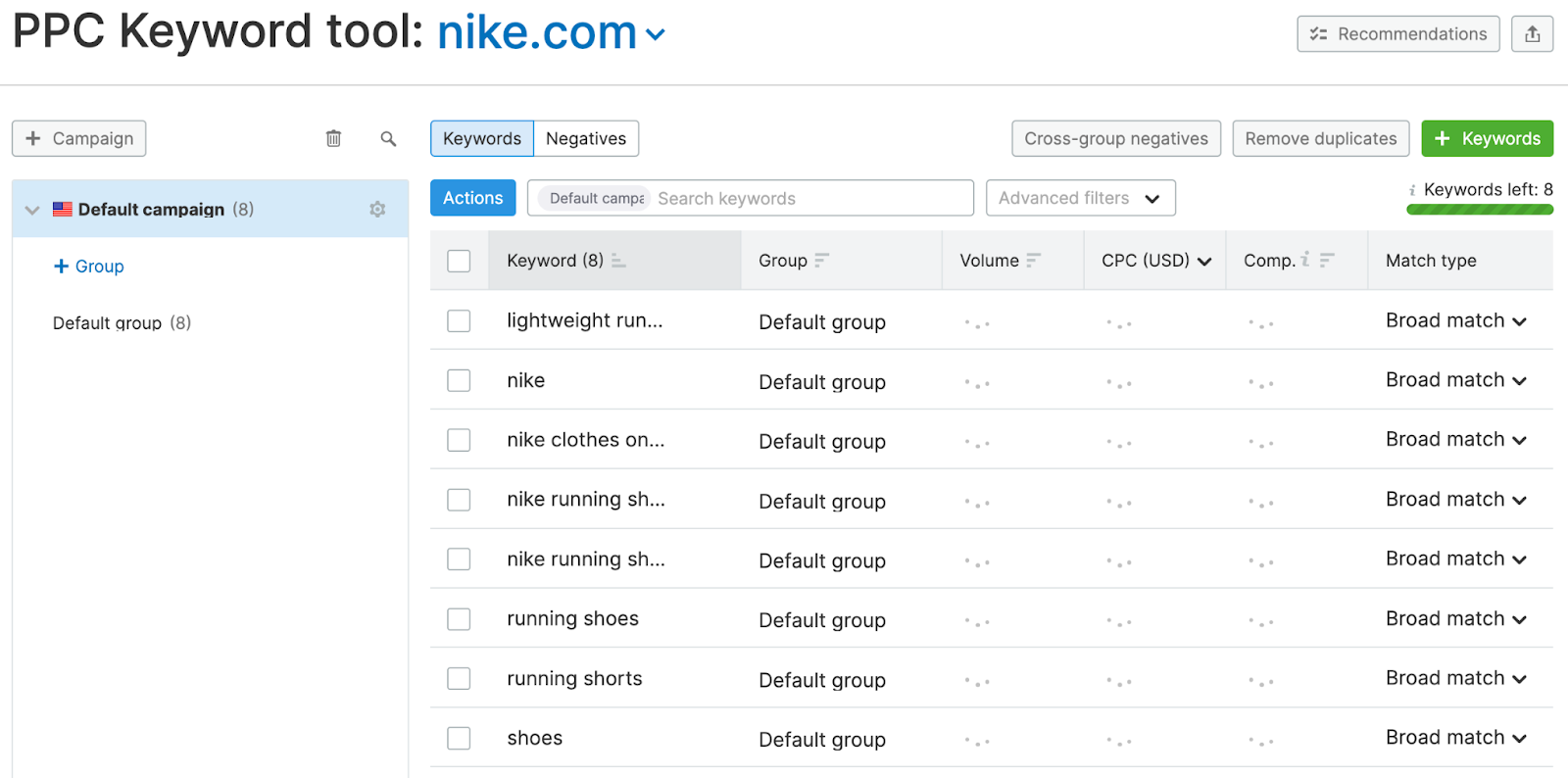
Once you’ve curated your keyword list, analyze the potential traffic and the estimated cost per click (CPC) for these keywords.
You can then implement these keywords into your campaigns for better targeting and improved ad relevance.
Further reading: Follow our in-depth setup guide for more information on configuring the PPC Keyword Tool.
Google Display Ads
Instead of keywords, Google display ads rely on targeting criteria like user interests, demographics, or specific topics.
When a user visits a website within the Google Display Network, Google’s algorithm assesses the page's content, the user’s past behavior, and the targeting criteria set by advertisers.
The algorithm then displays the most relevant ads on the page.
Google Shopping Ads
For these ads, Google uses the product data you submit through its Merchant Center account:
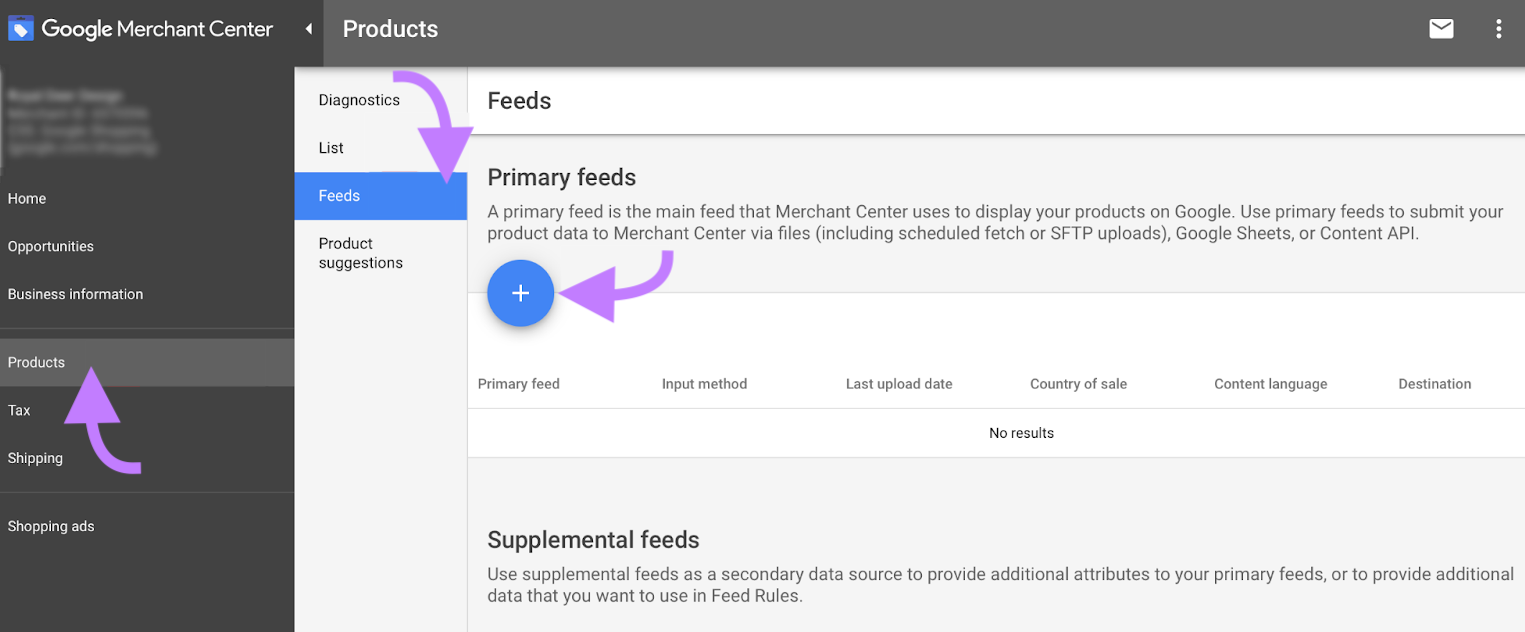
When a user searches for a product, Google’s algorithm compares the search query with your product data.
It then ranks the ads based on relevance, bid amount, and product’s customer rating.
The top-ranking products appear in the shopping carousel.
Google Video Ads
These ads use both demographics and interest-based targeting.
Google evaluates the video content the viewer is watching and their previous video interactions.
Based on these factors and the specific audience criteria you’ve set (like age, gender, or interests), Google decides whether your ad is a good fit.
The combination of your bid and Quality Score then determines whether your ad is displayed. And where it appears in the video—before, during, or after the video.
Google App Ads
Google app ads are automatically generated in different formats and for various platforms using the text ideas, images, and videos you provide.
These ads are then targeted based on user behavior, search history, and other contextual factors (such as location, device type, and time of the day).
The algorithm considers your bid and Quality Score to place the ad across Google’s ecosystem.
It tests different asset combinations to reach the most relevant audience with the most effective ad.
Are Google Ads Worth It?
According to estimates of Google’s economic impact report, for every $1 a business spends on Google Ads, they get $8 in profit through Google search and Ads.
Not bad!
Google and YouTube process billions of searches daily. The Google Display Network reaches over 90% of internet users worldwide.
This vast reach highlights the unparalleled potential of advertising with Google.
Numerous case studies show the effectiveness of Google advertising:
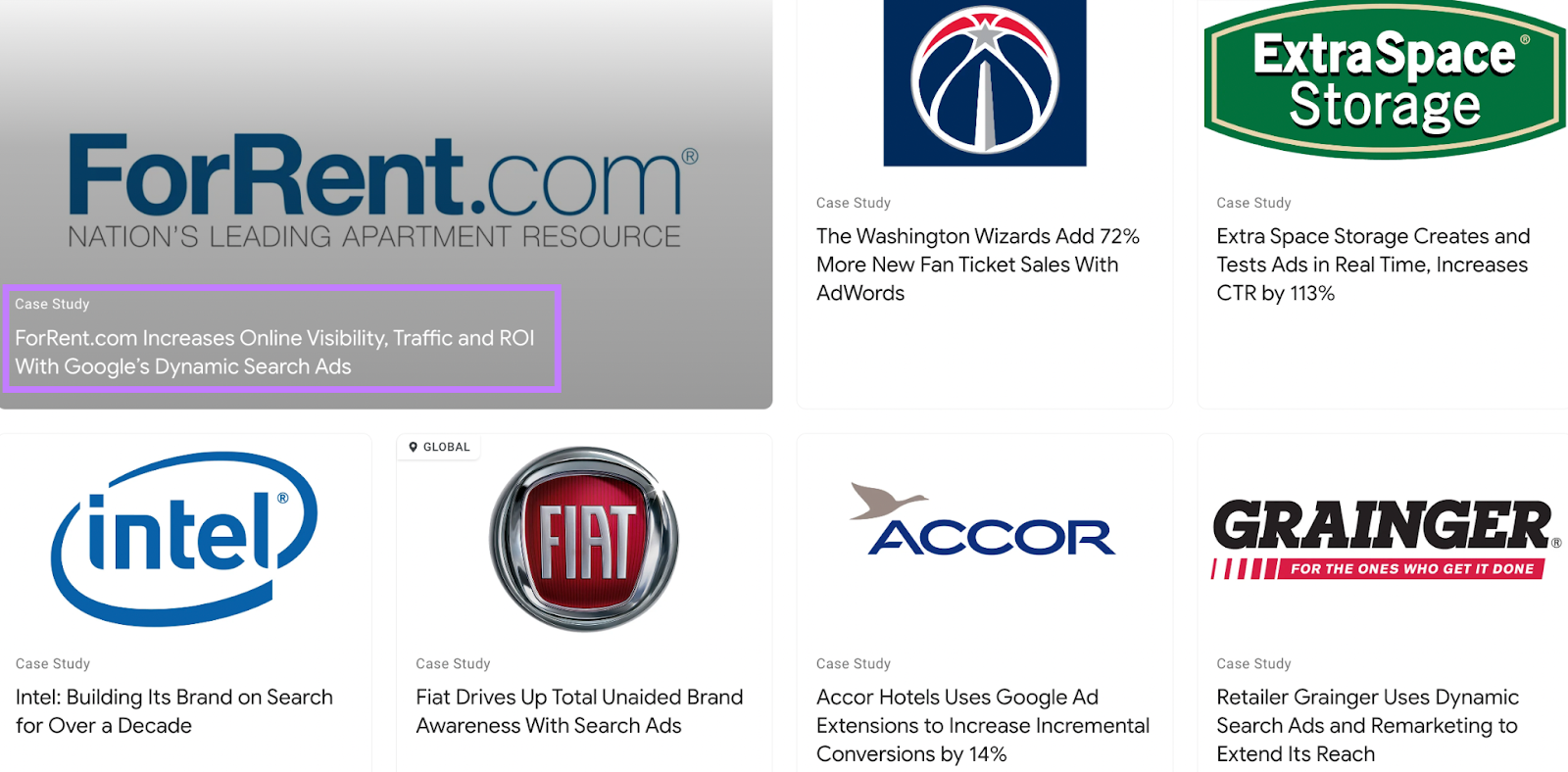
Google Ads offers high reach and the flexibility to target potential customers based on their behaviors, interests, and search patterns.
By linking Google Ads with Google Analytics, you can gain deep insights into your campaign performance. This lets you optimize your ads in real time and maximize results.
Yes—starting with Google Ads will require you to invest upfront.
But its potential to drive profit and growth makes it an effective tool that’s often worth that initial investment.
How Much Does Google Ads Cost?
Google Ads costs can vary widely, depending on factors like ad type, industry, location, and competition.
On average, businesses spend between $1 to $2 per click for search ads. And under $1 for display ads.
However, highly competitive industries like insurance or legal services can see CPC upwards of $50.
Since Google Ads costs are not fixed and can fluctuate based on demand, your budget can range from as low as $50 per month to thousands of dollars for larger campaigns.
Ready to Launch Your Google Ads Campaign?
To show ads on Google search, you begin by setting up your Google Ads account and creating a campaign.
The process will include defining your campaign goals, selecting keywords you want to target, creating your ad copy, and setting your budget.
But even before that, you want to create an ad strategy built on competitive analysis.
Ask yourself:
- What keywords are your competitors bidding on?
- What kind of ad copy are they using in their campaigns?
- How much are they paying for an ad click?
You can find answers to such questions and get more insights with Advertising Research.
Here’s how.
Open the tool, enter a competitor’s domain, and click “Search.”
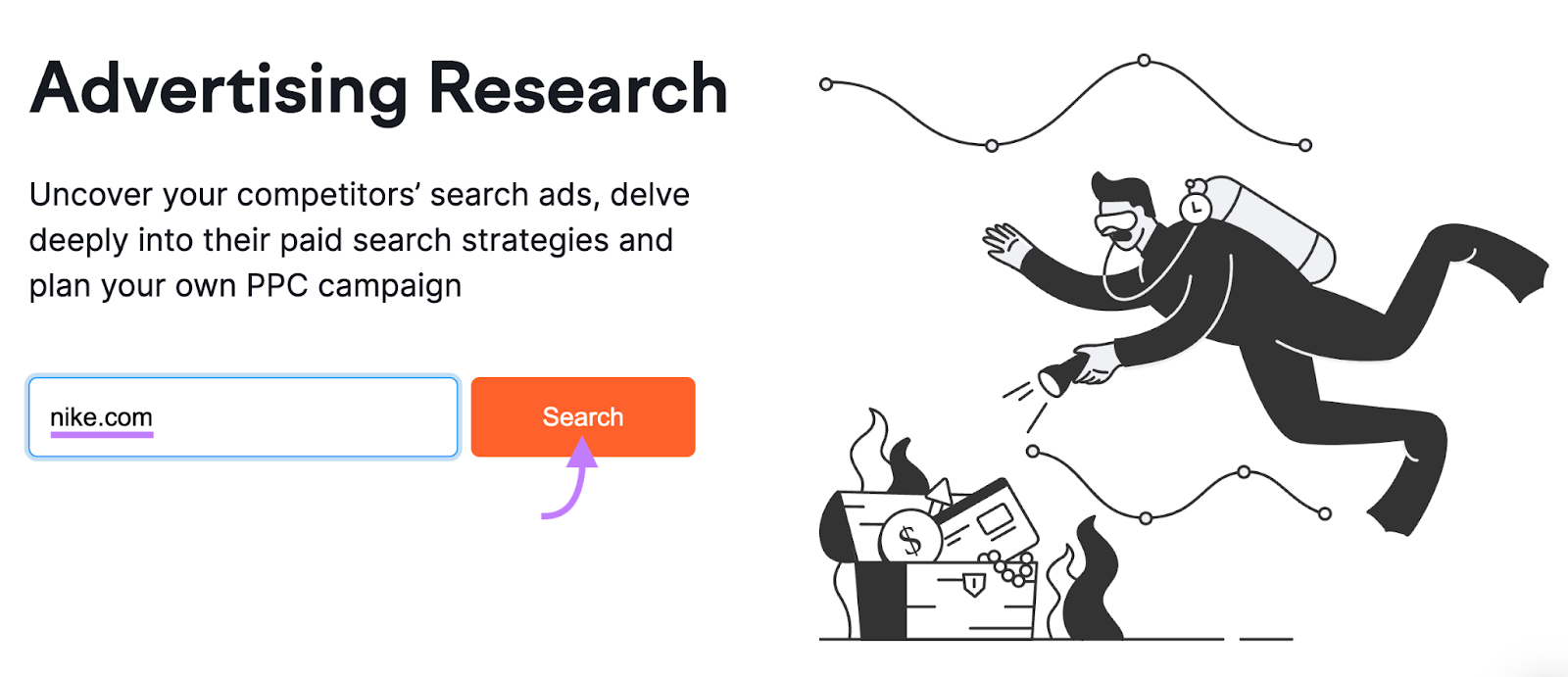
You’ll find several tabs in the dashboard: “Positions,” “Position Changes,” “Competitors,” “Ads Copies,” “Ads History,” “Pages,” and “Subdomains.”
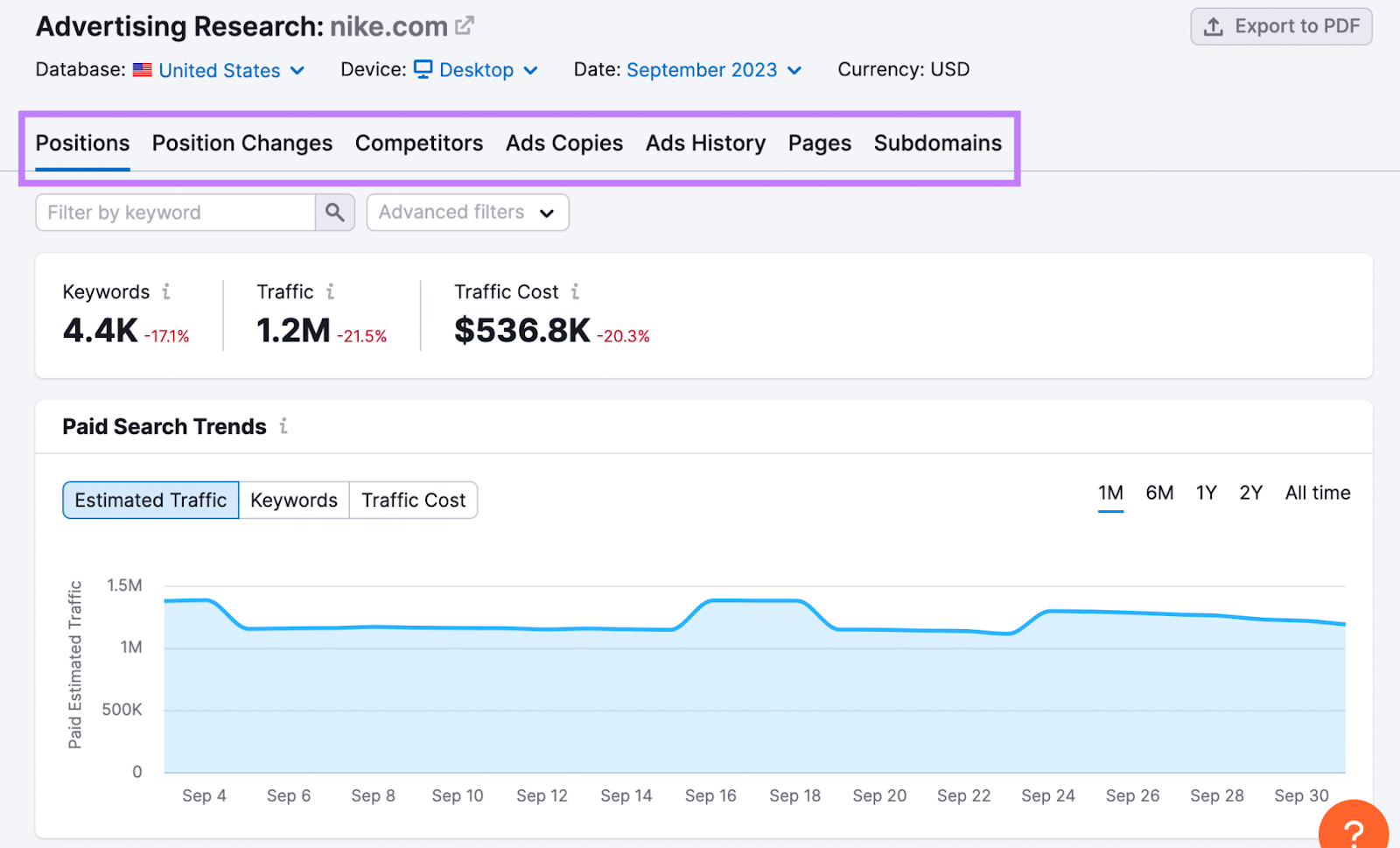
Under the “Positions” tab (default), scroll down, and you will find a list of keywords your competitor is ranking for in Google's paid search results.

You can analyze the keywords and CPC to uncover new advertising opportunities. And compete in areas your competitors are investing in or are weak at.
Next, click “Ads History.”
You’ll then see something like this:
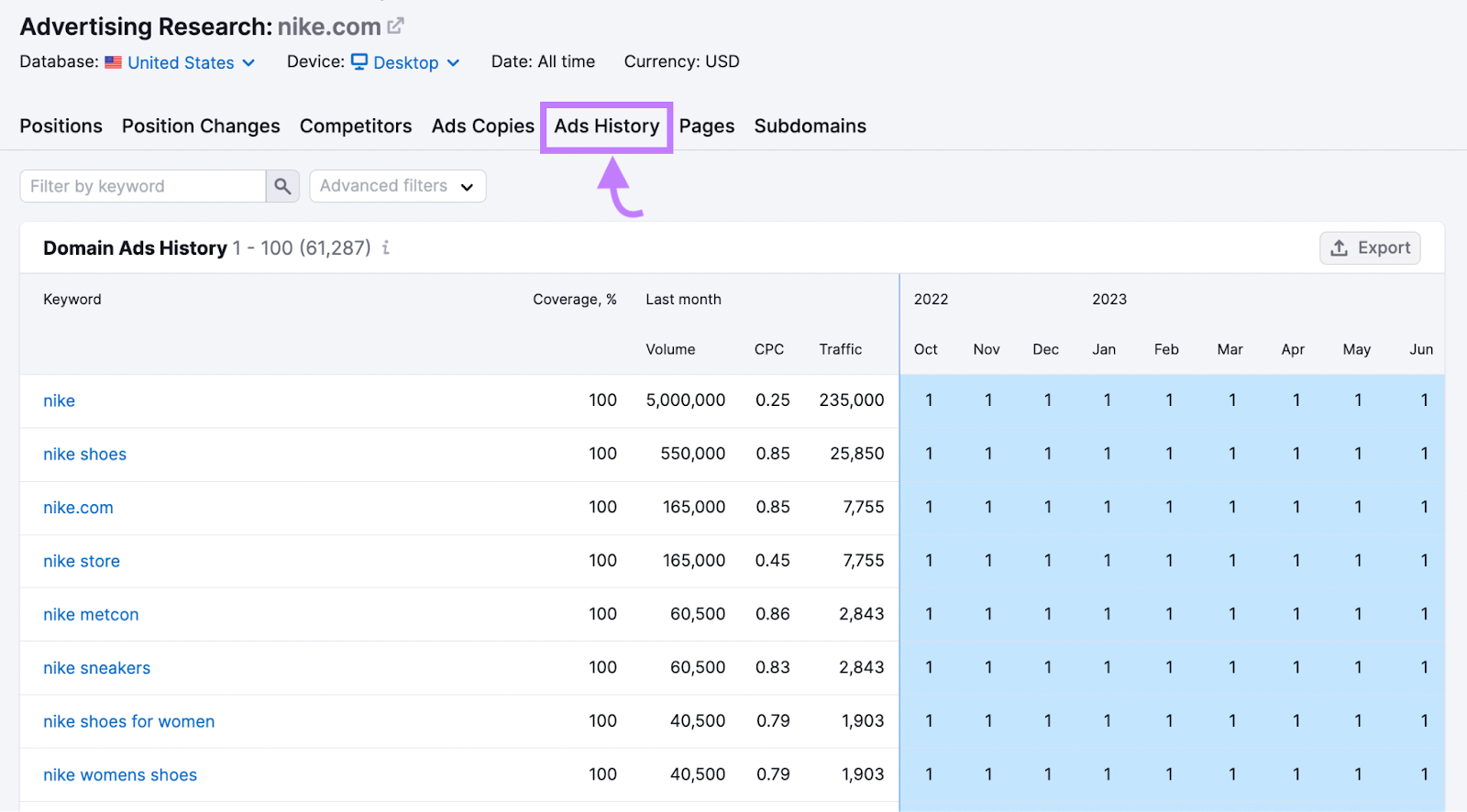
Ads History report gives you a complete rundown of all the keywords your competitor has ranked ads for in the past months.
Clicking on any box in the monthly grid will reveal the specific ad copy your competitor tested for the corresponding keyword during that month.
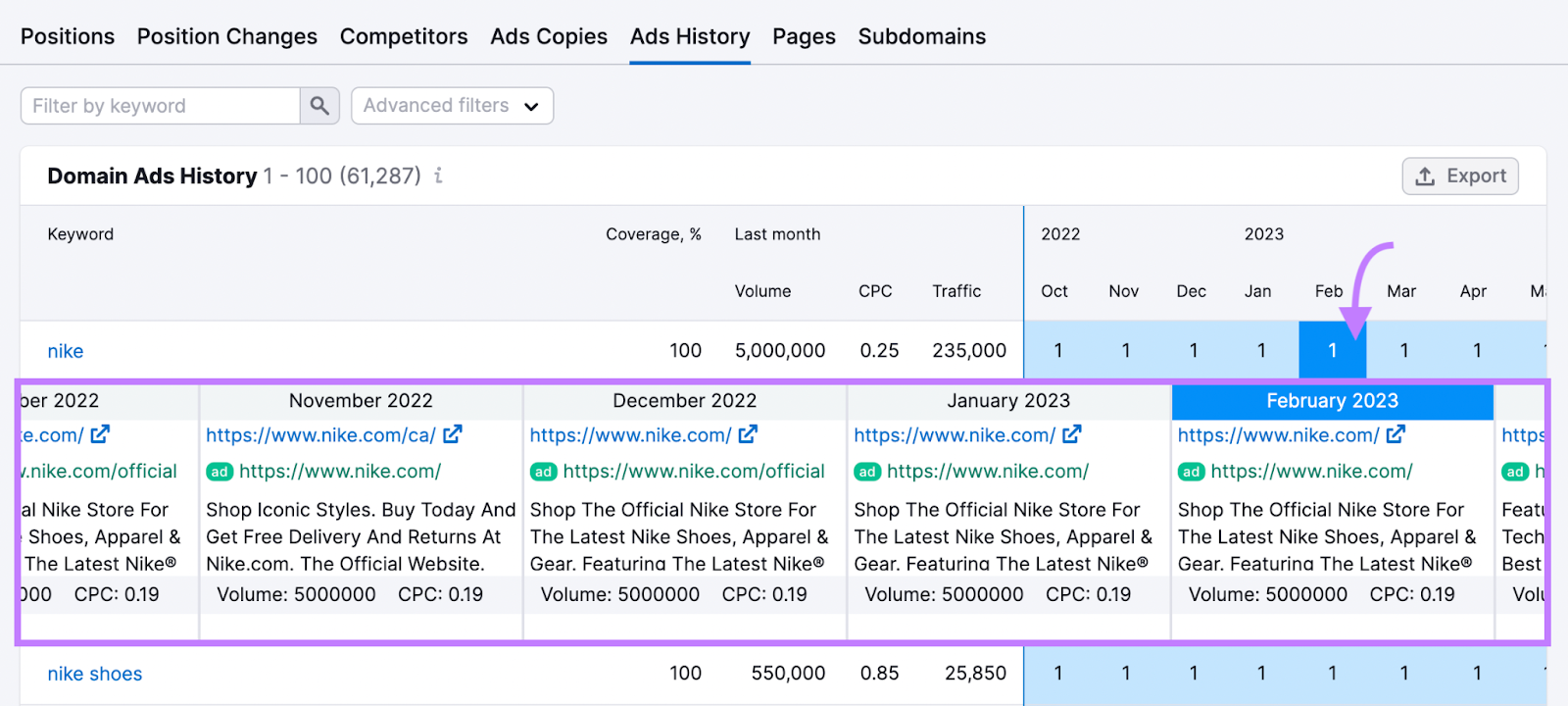
The Advertising Research reports can provide deep insights into your competitor’s ad strategy. Which helps you create Google paid search ad campaigns optimized for quality, relevancy, and cost-effectiveness.
Get started with Advertising Research for free. And launch your Google search ad campaign successfully
